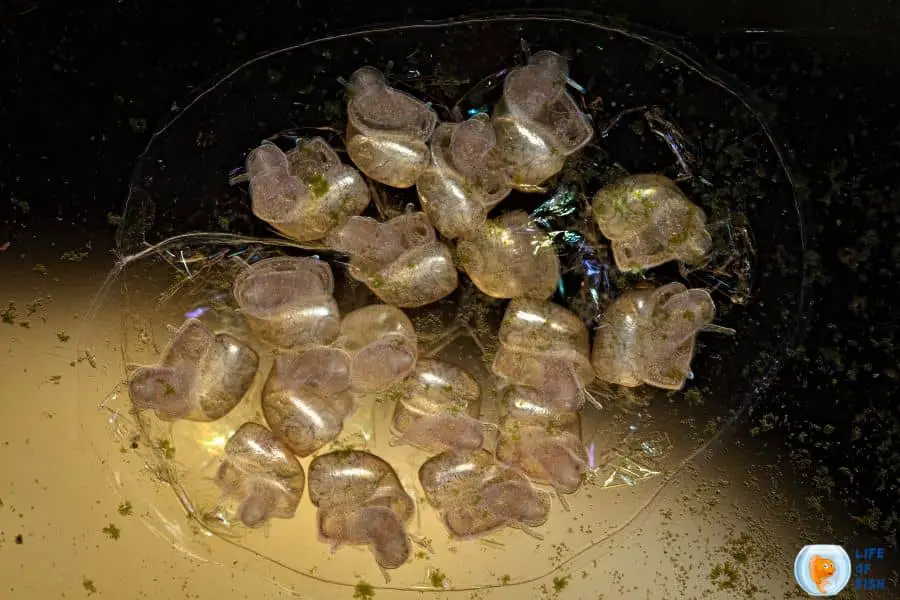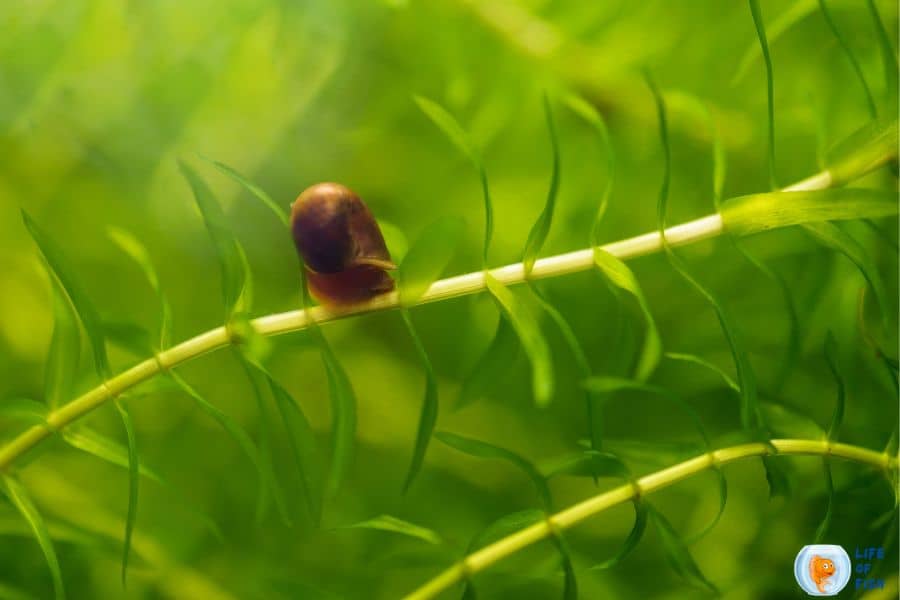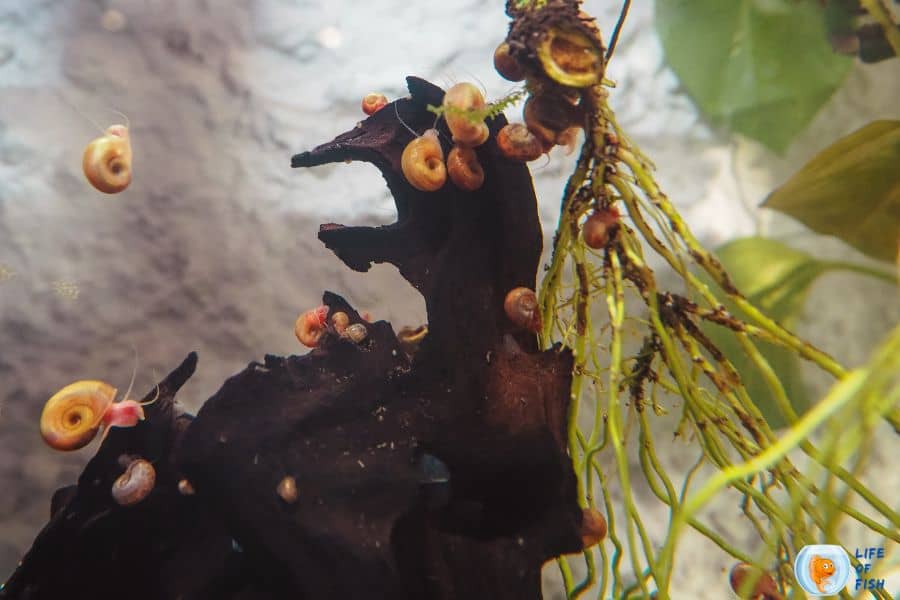How to get rid of snail eggs in aquariums? There are several ways to remove snail eggs from your aquarium. One popular method is to scrape them with a thin card. But there are other options as well.
Snails can be a great addition to any aquarium only if you introduce them to your aquarium. If they hitchhike into your aquarium through plants and other means, they probably can be pests.

These pests can remain hidden for a long time and suddenly explode. Why? Because they reproduce rapidly.
Most snails lay snail eggs and multiply their population in the aquarium so fast. So, it is important to destroy the chain by getting rid of snail eggs ASAP.
This comprehensive guide will assist you in understanding how to get rid of snail eggs in aquariums so that your home doesn’t turn into a snail farm.
Where do aquarium snails lay their eggs?
Jump To
- 1 Where do aquarium snails lay their eggs?
- 2 What do snail eggs look like in a fish tank?
- 3 How long do snail eggs take to hatch in an aquarium?
- 4 How many babies do snails have in a fish tank?
- 5 Are snail eggs invasive?
- 6 Is disposing of snail eggs necessary?
- 7 How to get rid of snail eggs in aquariums?
- 8 How to prevent snail infestations in aquariums?
- 9 What eats snail eggs in a fish tank?
- 10 Conclusion
The place aquarium snails lay eggs differ from species to species. Some lay eggs on the sides of the aquarium.
Some snails lay them on the substrate, under rocks or plants. Snail eggs are commonly found under plant leaves.
On the other hand, Mystery snails lay their eggs above the waterline. This is because their eggs need to be exposed to air for them to hatch.
Some snails, such as the Malaysian Trumpet snail don’t lay eggs at all. These snails are live-bearers which means they give birth to snail babies.
If you want to find snail eggs, you need to keep a close eye on these common snail hiding spots:
- On the glass walls of the aquarium.
- Under plant leaves.
- The substrate.
- Driftwood.
- Rocks.
- On the decorations and
- On aquarium equipment like filters and air tubes.
What do snail eggs look like in a fish tank?
Most snail eggs in aquariums will be white, gelatinous, and translucent. They are usually small dots that look like grains of sand or perhaps dirt specks. As the embryo inside the eggs grows, the color of the eggs will get darker.
Some snails, such as mystery snails, lay egg clutches. These clutches will be grouped together and can easily be seen with the naked eye. The clutches are usually located near plant leaves or on the glass walls of the aquarium.
If you see some white dots on the leaves of your plants or on the glass, it is most likely snail eggs.
You can use a thin card like a credit card to scrape them off the surface, making sure you don’t harm your plants in the process.
How long do snail eggs take to hatch in an aquarium?
The length of time it takes for snail eggs to hatch can vary depending on the snail species and the water’s temperature.
It takes anywhere from 2 to 6 weeks for snail eggs to hatch in most cases. During this time, the color of the snail eggs will change from white to dark brown or black.
Once the snail eggs hatch, the baby snails will be tiny, about the size of a pinhead. They will hide in the aquarium until they grow big enough to come out and start eating.
How many babies do snails have in a fish tank?
The number of baby snails that a snail can have in an aquarium depends on the species. While most species lay hundreds of eggs at a time, very few will be able to hatch successfully.
Some types of snails, like Malaysian Trumpet snails, can have up to 50 baby snails at a time. Other species, like Nerite snails, can have anywhere from 2 to 6 baby snails at a time.
However, about 30 to 40% of snail eggs will hatch successfully on average.
This means that if a snail lays 100 eggs, only 30 to 40 baby snails will be born. The remaining eggs will either be eaten by other aquarium creatures or will not hatch at all.
If you are worried about the rapid population growth of snails in your aquarium, it is important to get rid of the eggs as soon as you see them. The longer you wait, the more baby snails there will be.
Are snail eggs invasive?
Yes, snail eggs are considered to be invasive. This is because they can quickly multiply and take over an aquarium.
If you have a snail infestation, it is essential to take action immediately. You can remove the eggs manually or use other methods to get rid of them.
There are also aquarium-safe products available that can help you control the snail population in your aquarium.

Is disposing of snail eggs necessary?
If you know the snail species live in your aquarium and are not considered pests by your local aquarium society, you may not need to get rid of the snail eggs.
However, if you are unsure about the snail species or if you are worried about them taking over your aquarium, it is best to remove the eggs as soon as you see them.
If you have popular aquarium snails like mystery snails, nerite snails, or assassin snails, you may not need to worry about the eggs.
These snails are not considered pests, and they are not known to multiply rapidly. Further, you can earn some pocket money by selling baby snails to other aquarium enthusiasts. So, disposing of snail eggs of aquarium snails is not necessary.
How to get rid of snail eggs in aquariums?
There are several ways you can get rid of snail eggs in aquariums. While some may be considered inhumane, sometimes you have to do what is necessary to protect your fish tank.
But, try to follow humane methods as much as possible as these creatures are also living beings.
01. Using a thin card to remove snail eggs
The first method is to remove the eggs manually. You can use a thin card, like a credit card, to scrape the eggs off the surface.
Make sure you don’t harm your plants in the process. Since snail eggs are fragile, most snail eggs will be destroyed during this process, so most aquarists do not prefer this method. However, this is the most effective way to remove snail eggs.
02. Siphoning the eggs out
The second method is to siphon the eggs out of the aquarium. You can do this by using a small tube to suck the eggs out of the water.
This method is less likely to harm your plants, and it is also a more humane way to remove snail eggs.
However, siphoning is not effective in some snail egg infestations as the eggs are often hidden in hard-to-reach places.
03. Using a chemical treatment
The third method is to use a chemical treatment to get rid of the snail eggs. There are many products available that contain chemicals that can kill snail eggs.
However, you must take precautions with this procedure because some of these chemicals might be toxic to your fish and plants.
So, before using any chemical treatment, make sure you read the label carefully and follow the instructions.
04. Adding predators
The fourth method is to add snail egg predators to your aquarium. This is a more natural way to get rid of snail eggs. Some of the most common snail egg predators are fish, amphibians, reptiles, and invertebrates.
But, before you add any predator to your aquarium, make sure it is safe for the other animals in your tank.
05. Dip the plants and decorations in a bleach solution
The fifth method is to dip the plants and decorations in a bleach solution. This will kill the snail eggs that are attached to these surfaces.
But, you have to be careful with this method as bleach can also be harmful to your plants and fish. So, make sure you rinse the plants and decorations thoroughly before adding them back to the aquarium.
Important: Whichever method you use, be careful not to throw the snail eggs into the wild as this can cause an ecological imbalance. The best way to dispose of pest snail eggs is to freeze the eggs, crush them, and throw them away.
How to prevent snail infestations in aquariums?
While it is impossible to prevent snail infestations in aquariums completely, there are some things you can do to reduce the chances of them happening.
01. Quarantine new plants, substrate, and decorations
One of the best ways to prevent snail infestations is to quarantine new plants, substrate, and decorations before adding them to your aquarium.
This offers the opportunity to inspect them for snail eggs and remove them before they hatch.
02. Rinse plants and decorations in a bleach solution
Another way to prevent snail infestations is to rinse new plants and decorations in a bleach solution before adding them to your aquarium.
This will kill any snail eggs that are on these surfaces. But, make sure you rinse the plants and decorations thoroughly before adding them to the aquarium, as bleach can also be harmful to your fish and plants.
03. Keep your aquarium clean
Another way to prevent snail infestations is to keep your aquarium clean. This means doing things like changing the water regularly, cleaning the filter, and removing uneaten food. A clean aquarium is less likely to be infested with snails.
04. Keep an eye out for early signs of infestation
The best way to prevent a snail infestation is to watch for early signs of infestation and take immediate action. Some early signs of infestation include:
- Seeing adult snails in your aquarium
- Finding snail eggs on the aquarium glass or plants
- Seeing holes in your plants
If you see any of the above signs, take action immediately to remove the snails and their eggs from your aquarium.

What eats snail eggs in a fish tank?
Introducing the natural predators of snails and snail eggs to your fish tank is an organic approach to eliminating them.
That being said, I recommend doing your research to make sure the predator you introduce will not end up harming your existing fish population.
Here are some examples of natural snail and snail egg predators:
01. Clown loaches
Clown loaches will be an excellent choice if you have a large fish tank. They can grow up to 12 inches in length, so make sure your tank is big enough to accommodate them. Clown loaches are known to eat both adult snails and their eggs.
02. Pufferfish
Another good choice for a snail predator is the pufferfish. These fish are known to eat both adult snails and their eggs.
Pufferfish are also known to be aggressive, so make sure you do your research before adding one to your aquarium.
03. Cichlids
Cichlids are another excellent choice for a snail predator. These fish are known to eat both adult snails and their eggs.
Cichlids are also known to be aggressive, so make sure you do your research before adding one to your aquarium.
04. Cory catfish
If you want to eliminate snail infestations before the eggs hatch, consider adding a Cory catfish to your aquarium.
These fish are known to eat snail eggs before they have a chance to hatch. Cory catfish are also known to be peaceful, so they will not disturb your other fish.
05. Guppies
Guppies are a good choice for a snail predator if you have a small fish tank. They can cohabit well with snails but will eat snail eggs if they are unprotected.
While guppies may not suit extensive snail egg infestations, they are good at controlling beginner snail populations.
06. Bettas
Bettas are a good choice for a snail predator if you have a small fish tank. They are known to eat both adult snails and their eggs.
Bettas are also known to be aggressive, so make sure you do your research before adding one to your aquarium.
07. Assassin snails
The best snail and snail eggs predator is not a fish but a snail, the assassin snail. As their name implies, these snails are known to kill and eat other snails. They are a good choice for any aquarium with a snail problem.
Conclusion
If you have a snail problem in your aquarium, don’t worry. There are ways to get rid of them and their eggs.
You can also take steps to prevent them from entering your aquarium in the first place. By following the above tips, you can keep your tank pest-free and enjoy watching your fish swim around without any slimy roommates.
Credit to : What To Feed Aquarium Snails? (They Are Not Picky) Baby Snails Appeared In My Fish Tank And Control Them
